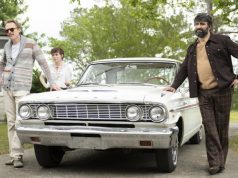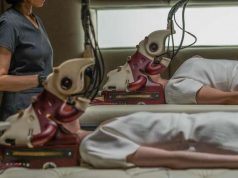Americans spend $40 billion a year on chicken products, and each person eats an average of 80 pounds of chicken annually.
Those are two of the less-entertaining facts presented in Mark Lewis’s “The Natural History of the Chicken,” a highly amusing documentary whose faux-pretentious title is the first clue that its exploration into the world of poultry will be tongue-in-cheek. (Or should I say, “tongue-in-beak”? No, I was right the first time. Tongue-in-cheek.)
“I believe that people one day will hopefully understand as I do … how wonderful a little chicken can be,” says Karin Estrada, a Palm Beach woman who dotes on her pet rooster like it was her grandchild, going so far as to put custom-made panties on him in case he has an accident in the house.
Other real-life characters introduced are Joseph Martinez, a Viriginia farmer of free-range chickens who tries to afford the creatures some dignity even up through the beheading process; Troy Waters, the grandson of the 1940s couple who had the side-show attraction headless rooster; Joel Vavra, a Nebraska man whose imitations of rooster calls are uncanny; and Janet Bonney, a Maine matron who gave mouth-to-mouth resuscitation when one of her pets lapsed into hyperthermia during a Nor’easter.
All of these chicken lovers speak without irony. Martinez seems to know, in the back of his mind, how odd it must seem to have fondness for an animal so generally disregarded; Vavra the rooster-imitator seems unaware, though. The CPR woman is so matter-of-fact (“I did give her mouth-to-beak,” she says simply) as to discourage any condescension toward her.
The film shows us another side of the story, too. Residents of Oxford, Ohio, were upset a few years ago when Bobby Wayne Webb moved to their quiet community and started raising roosters for cock-fighting. The locals weren’t mad about the cruelty of such sports; they were bothered by the 100 roosters’ non-stop noise-making all day, every day. They were bothered enough to take Webb to court, in fact.
Filmed with bright colors and vaguely self-conscious reenactments, the documentary aims to be as enjoyable to watch as it can be without resorting to humor at the expense of its subjects. Lewis generally does just let the people tell their own stories, supplementing them with sound effects or re-creations at times, but in a manner that bolsters the tales rather than smirks at them. The woman with the underwear-clad rooster, unfortunately, is allowed to over-act for the camera; aside from that, Lewis shows great restraint, putting in enough directorial touches to keep it interesting without turning it into a farce.
Informative? Not particularly. But who wants to know a bunch of stuff about chickens anyway? Real people with real feelings about chickens — THAT’S where the fun is.
B (; )





